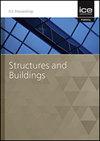Structural and Thermal Performance of a Novel Form of Cladding Panel: the I-beam Beetle Elytron Plate
IF 1.4
4区 工程技术
Q3 CONSTRUCTION & BUILDING TECHNOLOGY
Proceedings of the Institution of Civil Engineers-Structures and Buildings
Pub Date : 2021-11-12
DOI:10.1680/jstbu.21.00043
引用次数: 1
Abstract
To develop a nonbearing prefabricated straw sandwich concrete wallboard (I-beam beetle elytron plate: IBEPsc), the effect of certain structural parameters (e.g., panel thickness T, number of I-cores N and core height h) on the mechanical and thermal insulation performance was investigated by using the finite element method. The results are as follows: 1) The bearing capacity of the IBEPsc is controlled by the maximum principal tensile stress; the optimal structural parameters of the IBEPsc for a self-insulated wall with a large safety margin are presented. 2) The consideration of strips vs. whole plates and the selected upper bearing constraint type have little influence on the mechanical properties. In practical applications, the strips and whole plates can be reasonably selected according to engineering needs, and these components can be connected with the main structure by conventional mortar. 3) According to a qualitative analysis and comparison with common I-shaped thermal insulation walls, the IBEPsc requires the least material and weight while ensuring a sufficient safety margin in terms of mechanical and thermal insulation performance. Hence, biomimic techniques can play a key role in breaking through the limitations of traditional structures. This paper can help direct the application of beetle elytron plates in prefabricated wallboards.一种新型覆层板的结构和热性能:工字梁甲虫鞘翅板
为研制一种无承重预制秸秆夹芯混凝土墙板(工字钢甲虫翼板:IBEPsc),采用有限元法研究了面板厚度T、工字钢芯数N、芯高h等结构参数对其力学性能和保温性能的影响。结果表明:1)IBEPsc的承载能力受最大主拉应力控制;给出了大安全余量自保温墙体的最优结构参数。2)条带与整板的考虑以及所选择的上部承载约束类型对其力学性能影响不大。在实际应用中,可根据工程需要合理选择条和整板,这些构件可通过常规砂浆与主体结构连接。3)通过与普通工字型保温墙体的定性分析和对比,IBEPsc在保证力学和保温性能有足够的安全余量的同时,对材料和重量的要求最少。因此,仿生技术可以在突破传统结构的局限性方面发挥关键作用。本文对甲虫鞘翅板在预制墙板中的应用具有一定的指导意义。
本文章由计算机程序翻译,如有差异,请以英文原文为准。
求助全文
约1分钟内获得全文
求助全文
来源期刊
CiteScore
3.40
自引率
6.20%
发文量
61
审稿时长
12 months
期刊介绍:
Structures and Buildings publishes peer-reviewed papers on the design and construction of civil engineering structures and the applied research associated with such activities. Topics include the design, strength, durability and behaviour of structural components and systems.
Topics covered: energy conservation, people movement within and around buildings, strength and durability of steel and concrete structural components, and the behaviour of building and bridge components and systems

 求助内容:
求助内容: 应助结果提醒方式:
应助结果提醒方式:


